Richard Tubb's Blog, page 40
February 15, 2022
Why Working with Your MSP Competition Isn’t as Crazy as it Sounds
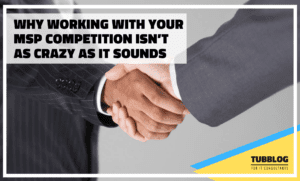 TL;DR, : At the CompTIA user group, Richard Tubb spoke on the challenges and benefits of working with your MSP peers; how to make the initial connections at events, when to refer third parties, and when not too, and how to mitigate the risks of a bad referral.
TL;DR, : At the CompTIA user group, Richard Tubb spoke on the challenges and benefits of working with your MSP peers; how to make the initial connections at events, when to refer third parties, and when not too, and how to mitigate the risks of a bad referral.
Hosted By CompTIA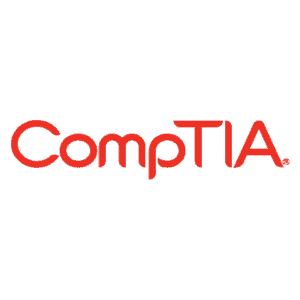
Chair:
Sameera Deen – Solution Provider Relations Specialist at CompTIASpeaker:
Richard Tubb – The IT Business Growth Expert at Tubblog Networking with your MSP Peers
Networking with your MSP PeersRichard talked about the different types of relationships you can have with fellow MSPs, and the benefits of these relationships. Working with other MSPs may not be as scary as it at first sounds.
Referrals should never be made for financial reasons alone. Anyone you refer should be someone you “Know, Like and Trust”.
Whether it’s a third-party recommendation, or as a subcontracted entity within your own business, bad service will ultimately reflect unfavourably on you and your business.
Therefore, it’s worth taking the time to know who you’re recommending, and how you’re working with.
Richard gave some great tips on how to network, and said this is something all MSPs can do now, even if they don’t think they’ll need to work with their competitors.
To build up a rapport within the community was an investment, and an opportunity not to be missed. That to give up your time and expertise in order to foster good relations is never a waste of time.
A tip Richard mentioned was to write your specialist area of expertise on the back of your business cards, so that when you hand them out at community events, you’ll stand out amongst the crowd for your focus in a particular area.
Though some of the delegates had bad experiences to share, it was generally agreed that the MSP community is a generous community who want to help if they can.

You may need to work with other MSPs for any or all of these reasons:
Geographical SpreadFor example, when you can’t reach all of your client sites effectively for support.
An MSP who already knows the area can have the experience you’re lacking when procuring the right resources.
Technology ExpertiseYou need to implement new technologies but lack expertise in-house.
Richard suggested the Meetup app was a good way to find technology user groups in your area. The opportunity to meet with people face-to-face is a great way to engage and develop a relationship where they could be in a position to help or recommend contacts to you.

You may need more staff to provide the standard services you offer, while you focus on developing your business. Whether its acquiring new contracts, or expanding your portfolio to include more higher-level services.
It might just be because you need a bit of breathing space so you can have a holiday.
For further reading Richard recommended ‘The Go-Giver’ by Bob Burg and John Mann, as an example of how giving can lead to a successful business.
Richard added that the “Go Giver” was definitely applicable in the Managed Services community.
ConclusionWhile working with other MSPs (also called building Strategic Alliances, or “buddying up”) or IT businesses may feel scary, the benefits far outweigh the concerns.
Whether it is to add complimentary technical skills, pool additional resources or even gain coverage in an area outside your local geography, buddying up with other IT companies can serve your MSP business well.
Would you ever consider buddying-up with another MSP to deliver your services? I’d love to hear your comments on the subject.
If you’re a CompTIA member, you can access the replay of this user group session!

 You Might Also Be Interested InBlog – The Power of Help Through Your Local MSP Peer GroupsResource – The 2022 List of Awesome Events for MSPsPodcast – How to Niche Your MSP and Navigate M&As
You Might Also Be Interested InBlog – The Power of Help Through Your Local MSP Peer GroupsResource – The 2022 List of Awesome Events for MSPsPodcast – How to Niche Your MSP and Navigate M&AsThe post Why Working with Your MSP Competition Isn’t as Crazy as it Sounds appeared first on Richard Tubb.



February 14, 2022
Powerful Video Help for MSPs on GDPR – Privacy Kitchen
 When it comes to video help for MSPs on GDPR, there is only one choice for me.
When it comes to video help for MSPs on GDPR, there is only one choice for me.
On the 25th May 2018, new rules relating to how we collect and process personal data came into effect.
The UK General Data Protection Regulation (GDPR) was born.
Suffice to say, at the time, most IT Managed Service Providers (MSPs) saw GDPR as a headache to be tolerated.
However, it’s my opinion that GDPR highlighted the important issue of data privacy and security and brought valuable opportunities for MSPs.
So many small and medium sized (SMB) businesses either weren’t aware of good data privacy practice, or just didn’t care.
As a result, I’d say that GDPR raised the bar for data security and privacy.
Nevertheless, if you’re an MSP who needs to understand GDPR in order to educate your clients — where do you begin?
Might I suggest you organise a trip to Privacy Kitchen?
Video Help for MSPs on GDPRBack in 2018, if you had asked me if I’d find talking about GDPR exciting, then I’d have thought you’d lost your mind.
But fast-forward to the present day, and I’m an avid viewer of the video series Privacy Kitchen.
Privacy Kitchen is a regular series of videos produced by Robert Baugh, Founder and CEO of Keepabl, with help for MSPs.
(Full disclosure:- I’m an advisor to Keepabl and one of the reasons I’m invested in the Keeapabl platform is that it is exceptionally MSP-friendly).

 If you’re unfamiliar with Keepabl, it is a Software-as-a-Service (SaaS) solution that helps Small and Medium (SME) sized businesses with their compliance.
If you’re unfamiliar with Keepabl, it is a Software-as-a-Service (SaaS) solution that helps Small and Medium (SME) sized businesses with their compliance.
In a nutshell, the Keepabl solution is a governance and service platform.
As a result, Keepabl helps MSPs and other businesses become compliant (and very importantly, stay compliant) with GDPR and other data regulations.
Furthermore, if you are interested in finding out more about Keepabl, then check out the video demo I recorded with Robert at Keepabl – Powerful Compliance-as-a-Service for MSPs.
Alternatively, you can also listen to my podcast interview with Robert on TubbTalk #56 – Compliance as a Service for MSPs.
Privacy Kitchen – Video Help for MSPs on GDPR Through the Privacy Kitchen video series, Robert offers video help for MSPs on GDPR and all things privacy.
Through the Privacy Kitchen video series, Robert offers video help for MSPs on GDPR and all things privacy.
Whether you’re an IT company, involved in security, operations, legal or compliance, or if you’re the Data Protection Officer (DPO) for your business, then Privacy Kitchen is something you should be watching.
I’d go as far as to say that if you’re “also” the DPO for your business (amongst many other roles) then Privacy Kitchen is essential for you to watch!
Here are three of the Privacy Kitchen videos I’d recommend you start out watching.

In this video, and in less than ten minutes, Robert explains what GDPR actually is.
From why GDPR came in, to nuanced changes on consent and legitimate interests, to key changes for controllers and processors – this video explains it all.
10 Steps to GDPR ComplianceIn this video, 10 Steps to GDPR Compliance [8 mins 39 secs], in the time that it takes to drink a cup of coffee, Robert will change how you look at Compliance and make GDPR a revenue generator.

Could you identify a data breach?
In this video, Robert looks at what exactly a personal data breach is, then identifies the 3 types of breach, shares 4 key facts for dealing with data breaches, and looks at 20 examples from regulators!
ConclusionThe Privacy Kitchen series provides valuable video help for MSPs on GDPR.
Robert Baugh of Keepabl has made it easy for any IT business to learn about the challenges, and opportunities, of GDPR.
As as result of his efforts, Robert has produced over 35 videos with help on privacy questions.
You can find out more about Privacy Kitchen – Free Video Help With All Things Privacy.
Additionally, you can subscribe to the Privacy Kitchen YouTube channel.
Plus, I’d also highly recommend following Robert Baugh on LinkedIn, as Robert regularly shares important data privacy news and updates.
Thank you Robert and the team at Keepabl for helping any IT businesses looking for GDPR advice and guidance!
How has your MSP business found helping your clients with their GDPR queries? Has this been a challenge or a golden opportunity for you?
Please let me know. Leave a comment below or get in touch!

The post Powerful Video Help for MSPs on GDPR – Privacy Kitchen appeared first on Richard Tubb.



TubbTalk 105: How Content Marketing Gives MSPs Results
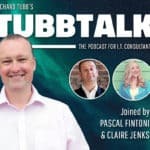
I speak to Claire Jenks and Pascal Fintoni about content marketing for MSPs. Claire helps tech businesses, consultants and memberships reach their potential and make the biggest impact through design, content and business management. And Pascal is a digital marketeer, video marketing expert, speaker, trainer and webinar host who helps businesses build their online reputation.
Watch the Interview VideoWhy Content Marketing is a Good Fit for MSPsClaire explains that some MSPs might actually be using content marketing without actually knowing that’s what they’re doing. If you have valuable knowledge you want to share with the world, then that’s where it comes in.
To become an authority in your field, or get your content to a bigger audience, you need a clear process to market yourself successfully. It helps you communicate better with your existing customers, shows potential clients what you do, and lets them get to know you.
Why Content Marketing is so ImportantPascal explained that content marketing and the internet have completely changed the way customers find out about businesses. “Previously, the only information that customers could gather about you was whatever you chose to put out there.”
Businesses were in control of that information and when and how it was released. “Now, by the time somebody gets in touch with you, they have formed 80% of their opinion about you by accessing information at their leisure, in a format that suits them. And they get to know the person behind the brand.”
Three Helpful Phrases to Know in Content MarketingPascal shared three phrases that all MSPs should know. The first is ‘content marketing campaign’. It’s a long-term game, not an instant win. The campaign involves three elements that help you build success.
First is visibility, and involves leveraging the audiences of people who are ahead of you in business. Secondly, credibility is when you’ve nurtured people and they understand how you can help them. Finally, interactivity is about speaking to people and answering questions from prospects.
Next, ‘content series’ is a useful phrase to know. “Say you want to talk about cybersecurity, but you’re going to dig deep into the topic. You plan a series of six blogs, and at the end of it you’ll have explored everything.”
In contrast, a ‘content special’ could be a one-off, free downloadable guide with an ultimate checklist of what you need to know about cybersecurity. Either will position you as an expert.
How MSPs can Upgrade and Repurpose ContentRepurposing or upgrading your content makes things easier for you when it comes to marketing your MSP. You could take the six blogs about cybersecurity and combine them into an eBook which you sell or offer for free.
Pascal added: “The repurposing up needs to be part of your strategy, because too often people create one piece of content after another and the earlier things get forgotten. Repurposing helps show people that you’re the expert. But work with a writer or designer so you’re not doing it all yourself.”
How to Prevent Content Marketing OverwhelmWhen you start marketing your MSP, you might want to try everything that’s out there. But there are so many platforms and mediums that it can be overwhelming.
Therefore, Claire’s advice is: “Look at what you want to achieve and what’s possible. You have day-to-day business activities and a life as well. So, identify what will be most impactful. Start with one thing, put a process in place, and then if you want to do more, you might get more people involved.”
The Best Type of Content for MSPsWith so much choice, you might wonder what’s the best type of content to use for your MSP. The simple answer is, whatever you can be consistent with. So if you can commit to producing content regularly, it will work for you.
Some people like to write blogs, others prefer to create video. Choose whatever you’re most comfortable with and that you’ll enjoy doing often. And make sure you’re bringing value and show the audience you understand their pain points.
When to Outsource Your Content MarketingPascal explained: “People often tell me they don’t have time to work on their marketing. And I always reply that you make the campaign fit with the time you have available.
“If you want to do more, then you find people to help you with creating the content. If you can’t or won’t extend the time you give to content marketing, then outsource it to experts who do.”
How to Connect With Claire JenksClaire Jenks International Brand, Design and Content StudioConnect with Claire on LinkedInFollow Claire on TwitterHow to Connect With Pascal FintoniPascal Fintoni Digital Marketing Trainer and SpeakerConnect with Pascal on LinkedInFollow Pascal on TwitterHow to Connect With MeSubscribe to TubbTalk RSS feedSubscribe, rate and review TubbTalk in iTunesSubscribe, rate and review TubbTalk on Stitcher RadioSubscribe and rate TubbTalk on SpotifyFollow TubbTalk on iHeartRadioFollow @tubblog on TwitterMentioned in This EpisodeMark Copeman Helpdesk Habits: Become a helpdesk superhero and make yourself indispensable. You Might Also be Interested inPodcast: Why MSPs Need to Embrace MarketingContent Planning ToolkitWhat are the Common Mistakes to Avoid When Marketing Your MSP?The post TubbTalk 105: How Content Marketing Gives MSPs Results appeared first on Richard Tubb.



February 13, 2022
Behind The Geeks Show – Help To Grow Your MSP
Yet, it’s also very rewarding at the same time!
Behind the Geeks is a show created for all the other geeks out there running an MSP.
So what can you expect to see? Behind the GeeksBehind the Geeks is the brainchild of the illustrious leader of The Tech Tribe, Nigel Moore.Every Thursday morning at 9 am GMT (that’s 8pm AEDT) Nigel and I are joined by:-Pete Matheson — former MSP owner, content creator and business coach.Scott Riley — the founder of UK-based MSP, Cloud Nexus, one of the fastest growing MSPs in Europe (learn more about Scott and Cloud Nexus in conversation on How to Build A Successful Cloud Solution Provider Business).
Behind the GeeksBehind the Geeks is the brainchild of the illustrious leader of The Tech Tribe, Nigel Moore.Every Thursday morning at 9 am GMT (that’s 8pm AEDT) Nigel and I are joined by:-Pete Matheson — former MSP owner, content creator and business coach.Scott Riley — the founder of UK-based MSP, Cloud Nexus, one of the fastest growing MSPs in Europe (learn more about Scott and Cloud Nexus in conversation on How to Build A Successful Cloud Solution Provider Business).Plus, we invite you to join us too via YouTube or LinkedIn.
The Stories & Craziness of Running an MSPDuring Behind The Geeks, you’ll find that the chat is light-hearted, and entertaining, but we all share valuable lessons for MSPs.Therefore, expect tales of the mistakes, stories & craziness that Nigel, Pete, Scott and I have experienced in the trenches of running and selling our MSP businesses!Each week, we dig into the latest MSP news and take a deep dive into a HOT topic that’s super relevant to the MSP space.
As a result, you can expect to hear us talk about
MarketingSalesPricingPackagingPeopleService DeliveryMindset… and more!
For example, some recent episodes include…

 How Can I Watch Behind The Geeks?The best place to watch Behind The Geeks is via The Tech Tribe YouTube Channel.Plus, you can also tune into Behind The Geeks via LinkedIn or my Twitter channel.And, if you can’t join us live, every episode of Behind The Geeks is recorded and available to view on-demand.
How Can I Watch Behind The Geeks?The best place to watch Behind The Geeks is via The Tech Tribe YouTube Channel.Plus, you can also tune into Behind The Geeks via LinkedIn or my Twitter channel.And, if you can’t join us live, every episode of Behind The Geeks is recorded and available to view on-demand.
 Behind The Geeks – The PodcastDo you prefer to listen rather than watch?If so, then you can also subscribe to the Behind The Geeks Podcast.You can subscribe in your favourite podcast player, or listen to the Behind The Geek Podcast via the Web.
Behind The Geeks – The PodcastDo you prefer to listen rather than watch?If so, then you can also subscribe to the Behind The Geeks Podcast.You can subscribe in your favourite podcast player, or listen to the Behind The Geek Podcast via the Web.
 ConclusionRunning an MSP is tough, but you are not making this journey alone.As a result, you can learn from those who have been there, and done that.Join us every Thursday morning at 9 am GMT via YouTube or LinkedIn for the Behind The Geeks live-stream!Which topic would you like to see us cover on a future episode of Behind The Geeks?Leave a comment below or get in touch!
ConclusionRunning an MSP is tough, but you are not making this journey alone.As a result, you can learn from those who have been there, and done that.Join us every Thursday morning at 9 am GMT via YouTube or LinkedIn for the Behind The Geeks live-stream!Which topic would you like to see us cover on a future episode of Behind The Geeks?Leave a comment below or get in touch!
 You Might Also Be Interested InPodcast – Building The Tech Tribe for MSPs: An interview with Nigel Moore.Article – The Tech Tribe – An Awesome Community for MSPs: The Story Behind The Tech Tribe.The Top Five Most Powerful TubbTalk Podcast Episodes for MSPs
You Might Also Be Interested InPodcast – Building The Tech Tribe for MSPs: An interview with Nigel Moore.Article – The Tech Tribe – An Awesome Community for MSPs: The Story Behind The Tech Tribe.The Top Five Most Powerful TubbTalk Podcast Episodes for MSPsThe post Behind The Geeks Show – Help To Grow Your MSP appeared first on Richard Tubb.



February 11, 2022
What is a Cloud Solution Provider? My Definition of a CSP
 Do you know what a Cloud Solution Provider (CSP) is?
Do you know what a Cloud Solution Provider (CSP) is?
CSP is a term that has gained popularity in the past few years, thanks to the rise of Cloud Computing.
As the former owner of an IT Managed Service Provider (MSP) business, I am used to hearing the question “What is a Managed Service Provider?”
Therefore, I wrote about my definition of an MSP.
But fast-forward to today, and I’m just as frequently being asked the question “What is a CSP?”
Many businesses are looking for alternatives to onsite data storage and have begun exploring cloud solutions instead.
But there is a huge variety of options in the cloud marketplace. How does an organisation know which platform(s) to choose?
This is where a Cloud Solution Provider (CSP) can be of help.
What is a Cloud Solution Provider?A CSP is an IT company which provides and manages cloud solutions for its clients.
These clients might be small and medium sized businesses (SMBs), or multinational organisations.
The cloud solution the CSP provides will depend on the needs of each client, and will be tailored accordingly.
There are many specialist CSPs, who offer specific solutions, such as productivity, Customer Relationship Management (CRM), Enterprise Resource Management (ERP) and Unified Communications (UC).
However, in this article, I’m going to share my insight into a typical CSP who works with small businesses.

One of the earliest references to Cloud Solution Providers (CSPs) was from Microsoft.
The official Microsoft cloud programme is called Microsoft CSP.
As a result, a lot of IT providers who resell Microsoft products have started referring to themselves as CSP’s.
However, being a CSP can be much more than just reselling Microsoft solutions.
Which Solutions Does a CSP Offer? In terms of the solutions, a CSP may offer its clients:-
In terms of the solutions, a CSP may offer its clients:-
Therefore, in summary, if the data is stored in the cloud then you have a potential solution a CSP could offer to clients.
In reality, a good CSP offers a range of solutions to their clients — aiming to become a “one-stop-shop” for cloud solutions.
It is also worth noting that while a good CSP offers strong cloud solutions to their clients, a great CSP adds additional value.
This additional value comes as a result of the consultative guidance, support and strategy which matches up the client needs to the right piece of cloud technology.
In short, a CSP doesn’t just resell solutions — they wrap their own value around them.

 In the above examples, I’ve mentioned a number of 3rd party cloud platform providers.
In the above examples, I’ve mentioned a number of 3rd party cloud platform providers.
Typically, at the SMB space, most IT businesses who have become CSPs follow this model of reselling these solutions to their clients.
These solutions are known as Public Cloud solutions.
The benefits to the CSP of this model are that the heavy lifting of building the cloud-based infrastructure has already been done for them.
A CSP following this model doesn’t have to worry about finding a data centre, buying equipment, installing and managing it.
However, some CSPs do choose to build their own infrastructure.
This is known as building a Private Cloud solution.
This is a huge investment, and requires ongoing monitoring and maintenance.
It is an investment that is typically beyond the scope of the audience of this web-site — the owners of SMB-sized IT businesses.
Therefore, for the sake of this article, I’ll refer to CSPs as the type of IT companies who resell and manage these 3rd party public cloud offerings.
What Does a CSP do for a Client?For a small business looking to find help in moving their data to the cloud (or indeed, managing an existing cloud infrastructure), a CSP will be a great partner.
An IT Managed Service Provider (MSP) might help a client choose their on-site infrastructure, and then manage it.
In a similar vein, a CSP helps a client choose the right cloud solution and then manages it for them.
For the client, the advantage of working with a CSP is the reassurance of having your data managed by an expert partner who will give support when needed.

 Many 3rd party cloud platform providers — such as Google and Microsoft — offer their tools direct to buyers, in additional to via CSP resellers.
Many 3rd party cloud platform providers — such as Google and Microsoft — offer their tools direct to buyers, in additional to via CSP resellers.
This means that if a small business wanted to buy Microsoft 365, they can purchase it directly from Microsoft.
As a result of going direct, if the business needs assistance setting up the cloud solution, or ongoing support, they need to go to the provider.
The downside of this model is that while the likes of Google and Microsoft do offer support for direct clients — this support can be a frustrating experience.
In reality, the client is unlikely to have the technical skills to be able to effectively talk to a support team about their issues.
As a result, the advantage of working with a CSP is that you have an expert who can manage the platform for you.
If a client has any problems with their cloud infrastructure, the CSP will manage those issues for them.
For the vast majority of organisations who don’t have an internal IT resource, partnering with a CSP is the most sensible move.
Clients Safety Comes First with CSPsAnother benefit for an SMB in working with a CSP, rather than going direct, is security.
The world of cloud solutions changes at a rapid pace.
New features emerge, and so do new risks.
With cybersecurity being high on most organisations agenda nowadays, working with a CSP can help mitigate those risks.
A good CSP will specialise in cloud solutions and be aware of the latest changes and new challenges in the threat landscape.
Therefore, a SMB who works with a CSP will not only be ensured of getting the best use of the latest features, but that their data is kept safe too.
As a result, clients can actually save money by working with a CSP by avoiding paying for multiple cloud solutions that, in reality, do the same thing.

 If you’re an existing Managed Service Provider (MSP) then you likely have a number of clients with on-site infrastructure.
If you’re an existing Managed Service Provider (MSP) then you likely have a number of clients with on-site infrastructure.
As a result, you are paid to monitor and manage this infrastructure.
So the question is — why would you move that infrastructure to the Cloud?
As an MSP, won’t you lose income if you remove the clients on-site infrastructure?
What will be left for an MSP to do in the new cloud world?
If you move from the MSP to the CSP model, then you will have to find a different way to charge for the value of your services.
The value a CSP typically offers comes via the service, support and guidance they offer their clients on an ongoing basis.
When it comes down to it, the concept of being a CSP is much like the concept of being an MSP.
A good MSP doesn’t charge for their time, they charge for the skill and expertise the bring to the relationship.
For instance, while it may only take two minutes to change a setting in a cloud solution portal, knowing where and how to spend those two minutes can save a client hours or even days of frustration and delays.
As a result, CSPs need to focus on a value mindset and not a traditional cost+ mindset.
While this concept isn’t too different to the traditional Managed Service model employed with on-site hardware, many IT businesses struggle to adapt to this concept.
Consequently, while many MSPs are resisting the change, the reality is that clients see the benefits of moving to the cloud.
The Benefits of Cloud Computing for Clients Traditional on-site solutions are typically purchased as a capital expenditure (CAPEX).
Traditional on-site solutions are typically purchased as a capital expenditure (CAPEX).
As a result, your clients need to make upfront investments in hardware and software.
However, Cloud solutions are typically paid for on a monthly or annual basis. These payments are categorised as an operating expenditure (OPEX).
This means that there is rarely a big upfront investment for your client.
Traditionally, software was purchased as a license and owned by a client.
However, in the modern day, most businesses prefer the flexibility of cloud solutions for scalability.
If your client employs more staff, they can increase their monthly license count.
But, if your client downsizes, then they can reduce their cloud license count. As a result, your client hasn’t purchased licenses which they no longer need.
While there is still a place for on-site solutions, the majority of businesses are looking to the cloud to increase their flexibility and reduce their capital expenditure.
MSPs need to be aware of this shift in mindset and change their offering accordingly.

 If you’re an MSP, then Cloud solutions will almost certainly be a good addition to your existing portfolio.
If you’re an MSP, then Cloud solutions will almost certainly be a good addition to your existing portfolio.
Being an MSP and being a CSP are not mutually incompatible.
As a result, many MSPs offer their clients a choice of on-site infrastructure or cloud solutions.
In fact, the vast majority of MSPs that I know offer a hybrid mixture of cloud solutions and on-site infrastructure.
Then there are some CSPs, such as UK-based Cloud Nexus, who offer a pure Microsoft cloud-based solution to their clients.
You can check out my interview with Scott Riley, owner of Cloud Nexus, and his thoughts on How to Build A Successful Cloud Solution Provider Business.
Other MSPs, such as UK-based Abussi, have moved their existing MSP clients into a CSP model.
These CSPs don’t just sell 3rd party solutions to clients and make a small markup on resale.
Instead, much like the Managed Service model, these CSPs generate revenue revenue based on charging for the consultancy and ongoing support services they offer.
The Cloud Solution Provider model is not too different to the Managed Service Provider model.
In both models, your business is paid for the expertise you can provide, and the peace of mind you offer the client in managing their solutions.
Where Does a CSP Buy its Solutions From?In the traditional world, an MSP that sold hardware and software would buy their kit from a distributor.
These distributors provided a conduit between vendors and MSPs.
If we fast-forward to the modern day, a similar arrangement can be found for Cloud Solution Providers.
There are a range of cloud marketplace providers available.
These cloud marketplace providers (sometimes referred to as Cloud Service Providers, not to be confused with the subject of this article – Cloud Solution Providers) will offer a variety of cloud solutions to CSPs for resale to their clients.
Some of the most notable cloud marketplace providers in the UK include:-
GiacomPax8QBS:MSP (formerly known as Zedsphere)Zen SoftwareOther providers, such as 1Stack Cloud or Linode, offer a alternative to the big direct players such as Amazon, Google or Microsoft.
As a CSP, when it comes to finding a cloud marketplace provider (or distributor) then I’d encourage you to look around.
Ask for recommendations in your local peer group, or check out reviews in online communities such as The Tech Tribe.

 When your Cloud Solution Provider business is choosing a cloud platform to offer to your clients, always make sure to ask your distributor for details on:-
When your Cloud Solution Provider business is choosing a cloud platform to offer to your clients, always make sure to ask your distributor for details on:-
Things to look out for in cloud distibutor might include:-
The ease of using a provisioning portalClear pricing of productsThe potential margin on reselling productsSimple monthly reconciliation on per-client billingAutomated provision of cloud solutionsClient Self-Service (coupled with a strong approval process for the CSP)Most importantly, check how the provider will be keeping your data secure.
Ultimately, your responsibility as a CSP is to keep your clients data safe.
Make sure you take that responsibility seriously.
If you’re intrigued to know more about your legal responsibilities as a CSP, then read my article on The Top 5 Legal Questions Asked by MSPs about Cloud Computing.
ConclusionIf we were to summarise what I’ve written above in one sentence, it would be this.
Cloud Solution Providers don’t simply sell cloud products, they sell their expertise.
Many businesses and organisations of all sizes are looking to move their IT infrastructure from on-site to the cloud.
Cloud computing offers organisations more flexibility and scalability over their IT, and moves IT costs from the Capital Expenditure (CAPEX) accounting column to the Operating Expenditure (OPEX) column.
As a result, many IT businesses are adapting to these demands from clients. They are making a move to the Cloud Solution Provider (CSP) model.
Many Managed Service Providers (MSPs) are also choosing to move to the CSP model.
There are a variety of excellent Cloud Marketplace (or Cloud Distributors) available to CSPs to help them with this transition.
The CSP model (much like the MSP model before it) is proving successful for one reason:
CSPs don’t sell products, they sell their expertise.
A CSP may resell 3rd party cloud tools, but the value they offer to their clients is the knowledge and experience they bring to the table.
Therefore, the CSP model really isn’t so different to the MSP (Managed Services) model after all!
Please let me know what your experiences have been.
Have you made the transition from MSP to CSP? How did you find that transition?
Please leave a comment below or get in touch.

The post What is a Cloud Solution Provider? My Definition of a CSP appeared first on Richard Tubb.



February 9, 2022
How To Effectively Measure MSP Client Satisfaction
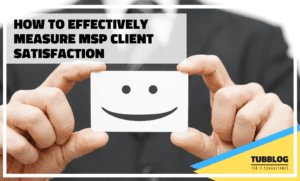 Why should you be measuring your Managed Service Provider (MSP) client satisfaction levels?
Why should you be measuring your Managed Service Provider (MSP) client satisfaction levels?
Well, if I asked you the question “How many of your MSP clients are happy, right now?” would you know the answer?
I like asking IT Solution Providers this question because you can probably tell me when your clients are unhappy, because they complain!
But when your MSP client is happy? I’d take a guess that you probably have no real idea!
The benefits of measuring MSP Client SatisfactionIt is worth putting in place ways to effectively measure your MSP client satisfaction (commonly known as CSAT) levels.
In many cases, we often make assumptions about whether clients are happy or not.
As a result, we can assume clients are happy even when, in reality, they are irritated!
In my experience, that irritation can soon fester and turn into anger if left unchecked.

 For instance, I once visited a client site to do a floorwalk.
For instance, I once visited a client site to do a floorwalk.
So, I wandered here and there, asking folks if I could help them with anything.
“Well, the printer over there isn’t working,” one lady told me.
“Ok, how long has it been like that?” I enquired.
“Oh, about eight months,” she said.
When I asked her why she’d not reported the faulty printer before, she told me she “never got around to it”.
I suspect that she would have got around to reporting the printer issue, and rather vocally, the next time she urgently needed to print something and didn’t have a working printer to do so.
The lesson here is, if you want your MSP to retain clients, then regularly gather CSAT feedback.
How to measure CSAT To avoid the type of issue I’ve highlighted from festering into something worse, you should be doing two things.
To avoid the type of issue I’ve highlighted from festering into something worse, you should be doing two things.
Firstly, making Customer Satisfaction (CSAT) something you invest in, rather than hoping for the best.
For example, I know several MSPs who use a platform such as SmileBack or SimpleSat for CSAT.
Both SmileBack and SimpleSat are custom-built tool for MSPs that are very simple to set up and use.
Secondly, commit to making gathering CSAT part of your MSP’s company culture.
Everyone in your business should be looking for opportunities to gather feedback from clients and take action upon it.

When it comes to encouraging clients to give you feedback, most Professional Services Automation (PSA) tools have an in-built facility.
Typically, any PSA helpdesk tickets that you send to clients can include a feedback request.
The problem with these PSA-based CSAT requests is that clients rarely, if ever, respond to them.
For example, most MSPs that I speak to who use PSA-based CSAT tools, typically only see a response of 1%.
As a result, PSA CSAT feedback is too unreliable.
However, the custom tools I mentioned above often yield results of up to 49% response rates.
That’s impressive, and will give your MSP a better chance of measuring how your clients are feeling about you.
Tools Don’t Replace The Human Touch It’s worth being aware, though, that no tool can replace the human touch!
It’s worth being aware, though, that no tool can replace the human touch!
As Derek Brown wrote in his guest blog post on The Pain of Acquiring Customer Feedback for MSPs, you need to be gathering feedback from many points — not just from surveys.
Therefore, I’d suggest that you maintain the human touch through regular MSP client satisfaction outreach.
For example, a routine telephone phone call to your client to ask them “Is there anything I can help you with?” is powerful.
Doing a regular floorwalk (COVID-safety permitting) of your client sites to see what is going on is also powerful.
As a result, human outreach is a simple but effective strategy.

 At the start of this article, I mentioned that most MSPs know how to deal with complaints.
At the start of this article, I mentioned that most MSPs know how to deal with complaints.
But what do you do with good feedback?
In my experience, many MSPs don’t celebrate great feedback from clients.
As a result, that warm glow you get when hear a client gives you strong feedback, soon evaporates.
Therefore, what if you set up a process to capture any positive feedback you’re given, and take action on it?
Some examples of taking action on good MSP client satisfaction feedback might include:-
Thanking the client through a gift (to reinforce the behaviour of giving good feedback)Asking the client if you can turn their positive feedback into a testimonial, to be used on your web-site (this type of “social proof” is powerful!)Requesting the client leave you a positive online review via Google MyBusiness (or a similar listing)Good feedback is something that great MSPs embrace, and utilise to grow their business!
ConclusionWhen it comes to measuring Customer Satisfaction (CSAT), most MSPs are missing a trick.
By implementing CSAT tools in your MSP business, you can start to build a culture of CSAT gathering.
When you start to gather CSAT from your MSP clients, you are keeping your finger on the pulse of your client relationships.
As a result, you can take action to head-off any issues before they fester.
Plus, you can celebrate good feedback, which will help you strengthen client relationships and grow your business.
Therefore, what are you going to start doing about collecting quality customer satisfaction feedback from your MSP clients?
Leave a comment below with your thoughts, or get in touch to let me know your ideas!

The post How To Effectively Measure MSP Client Satisfaction appeared first on Richard Tubb.



February 8, 2022
AI-Based Intelligent Alerting for MSPs
In this bonus episode of TubbTalk, I speak to Arvind Parthiban, co-founder and chief technology officer at  Superops.ai. We talk about their funding news, the new features they’re introducing and their AI based implicit alerting function.
Superops.ai. We talk about their funding news, the new features they’re introducing and their AI based implicit alerting function.
SuperOps provide PSA (professional services automation) and RMM (remote monitoring and management) for MSPs. Arvind explains that the platform is split into four distinct products.
There’s the PSA, the RMM, stock management and a project management and IT documentation layer. The product has been in production for two and a half years, and was launched with automation options.
The Implicit AI Alerting FunctionTo make sure they delivered the right solution for MSPs, SuperOps asked as many of possible to share their biggest pain point. “We didn’t talk about the features. We wanted to build something new that would solve their problems.
“Noise reduction was their biggest problem. An MSP gets hundreds and thousands of alerts a day, and they don’t know which one to deal with first. Our implicit AI alerting tool monitors all the anomalies and tells them which ones to prioritise. And it directly assigns each one to the right person.”
What the Funding Means for SuperOps and Their UsersSuperOps have just announced they’ve secured $14mof funding from Addition Capital and Tanglin Venture Partners, on top of $3m they raised in a previous funding round.
They have 17 angel investors, and have already earmarked the money for further developing and improving their product. They’ve been able to grow the platform much quicker than normal, and want to keep the momentum going.
Not sure what angel investing is? This article might help!
Future Plans and AI DevelopmentArvind explained that SuperOps are committed to building a product for the next 10 years. “What we have is ideal for the MSP with fewer than 10 technicians. Now we have this funding, we’re investing heavily in R&D.
“So, we’re going deeper into products, to build the basic functionalities. And we’ll add a layer of automation and make the MSP’s life easier. Then, we’re bringing in a ‘futuristic functionality’ – how they should work in future. AI is key to that.”
How the Team Plans to Maintain its User-Friendly EthosArvind says being user-friendly is part of the DNA of the company. “We know that our users are techies and like exploring for themselves. So many of our competitors have everything gated. They don’t give a free trial, for instance. And implementation is more of a handholding exercise.
“But we know that techies don’t work like that. They want to judge the product themselves So everything is transparent – you can try it without speaking to anyone first. And another key feature is to ensure that no matter what you want to do, it can be done in no more than three weeks. That’s user-friendly too.”
How to Connect with Arvind ParthibanSuperOpsFollow SuperOps on LinkedInFollow SuperOps on TwitterConnect with Arvind on LinkedInHow to Connect with MeSubscribe to TubbTalk RSS feedSubscribe, rate and review TubbTalk in iTunesSubscribe, rate and review TubbTalk on Stitcher RadioSubscribe and rate TubbTalk on SpotifyFollow TubbTalk on iHeartRadioFollow @tubblog on TwitterMentioned in This EpisodeAddition CapitalTanglin Venture PartnersYou Might Also be Interested inProfessional Services Automation: Does My MSP Need a PSA?A List of Powerful Remote Monitoring & Management (RMM) Tools for MSPsWhy Network Monitoring for MSPs is a Strong Opportunity
The post AI-Based Intelligent Alerting for MSPs appeared first on Richard Tubb.



February 7, 2022
The MSPs Guide to Modern Cloud Infrastructure
 I was recently invited to contribute to Linode’s new eBook “The MSPs Guide to Modern Cloud Infrastructure”.
I was recently invited to contribute to Linode’s new eBook “The MSPs Guide to Modern Cloud Infrastructure”.
With the explosion in demand for Cloud services affecting every IT Solution Provider and Managed Service Provider (MSP), this book has proved to be a very timely publication.
The book also shines a light on one of the real untapped resources in the MSP space, the so called “Alternative Cloud”.
What is the Alternative Cloud?Most MSPs are familiar with the big three cloud providers — Microsoft, Google and Amazon.
However, the alternative cloud space is one of the best kept secrets in the channel.
As a result, the alternative cloud is something that many smart, progressive MSPs are waking up to.
For instance, Linode offers Simple, Affordable and Accessible Cloud Computing and are the chosen supplier of a number of high profile MSPs such as Lawrence Systems.

Our book explores exactly what the alternative cloud is, and why the alternative cloud is such a great fit for so many MSP businesses.
The chapters of the book are broken down as follows:-
In Chapter 1: Understanding the Cloud Provider LandscapeThen, in Chapter 2: Improving KPIs with the Alternative CloudFollowing, Chapter 3: Alternative Cloud Use CasesPlus, Chapter 4: Security and the Alternative CloudFinally, Chapter 5: Alternative Cloud in ActionHow to download The MSPs Guide to Modern Cloud InfrastructureIf you run an MSP business, regardless of size, then you owe it to yourself to become aware of the alternative cloud market.
Visit the Linode website and download the eBook The MSPs Guide to Modern Cloud Infrastructure.
Have you started using the alternative cloud to help differentiate yourself from your competitors? If so, what impact have you seen on your business?
Leave a comment below or get in touch — I’m really interested in hearing your experiences.

The post The MSPs Guide to Modern Cloud Infrastructure appeared first on Richard Tubb.



TubbTalk 104: Cloud Networking, Cybersecurity and Cisco
 In this episode, Richard speaks to Michelle Ragusa-McBain, Global Lead and Channel Community Evangelist for MSP and XaaS at Cisco. And, Michelle is a former chair of CompTIA’s Advancing Women in Technology community and a driving force in the industry.
In this episode, Richard speaks to Michelle Ragusa-McBain, Global Lead and Channel Community Evangelist for MSP and XaaS at Cisco. And, Michelle is a former chair of CompTIA’s Advancing Women in Technology community and a driving force in the industry.
Michelle says that when she started her career, Cisco was focused on switching and routing. However, in recent years they’ve made acquisitions to support their MSP partners. They have something for everybody, and want to earn the trust of the community.
Cisco have an advisory council of partners who tell them what the MSPs need: “Security is number one, and marketing is second. We have an incredible security stack, and we have entry-level options for smaller businesses.”
Cisco Remote Cloud ToolsAs a result of the feedback from MSPs, Cisco have worked hard to develop three remote cloud tools to give them exactly what they need. Meraki allows MSPs to act as the ‘virtual CIO’ for their clients. They can monitor client networks and keep things running.
Second, Cisco offer a two-factor authentication (2FA) tool, called Duo. Michelle explains that it’s convenient and easy to use: “You can even use it on your Apple Watch. You’re asked for a passcode every time you log into a private domain, or it sends you a push notification. You approve it and log in straight away.”
Finally, Umbrella provides open DNS. It’s pay per user, month on month. It’s easy and intuitive to use, and both MSPs and end users love it. And it can be used for anything stored in the cloud.
What is XaaS?XaaS is the next step after SaaS (software as a service) and stands for either ‘everything as a service’ or ‘anything as a service.’ Many MSPs are already selling software or subscriptions, and XaaS allows them to widen their scope.
It applies to any IT function, including remote or in the cloud. Michelle adds that customers are becoming more informed about what their IT partners can do for them. So, you need to provide an easy, helpful solution that means they choose you over your competitors.
This detailed explanation of XaaS might also be helpful!
MSP-Focused Resources and Events from CiscoIn the next year or so, Cisco are planning to attend more events as well as adding more resources to their content libraries. Wherever possible, they try to share replays of their webinars and events.
“I now run a monthly webinar which is available to all our partners. We look at topics such as marketing, M&As, cybersecurity and business growth. We want to hear from the MSPs, so we can give them what they need. And we’re going to be at a lot of in-person events around the world. This is a great way for partners to meet us.”
How the MSP Space Has ChangedWhile Michelle says the industry has changed since she first joined, things have moved on rapidly in the last couple of years. “There’s been an insane number of mergers and acquisitions. And so many people have seen double digit growth during the pandemic.
“The other thing is that employees now feel able to say that they’re not happy in a role or even location. There’s a unique opportunity for MSPs to build a roadmap for the future. And to find a scalable solution that supports hybrid working for their clients and their employees.”
How Attitudes to Women in Tech Have ChangedWhile Cisco was always an equal opportunity company, the tech space as a whole has always been male-dominated. Michelle says we need diversity, “Because diversity makes the best products, solutions. It resembles your customers, who are also diverse and inclusive.”
She says that things are shifting, and CompTIA’s work has been key to this. But there’s still not enough women and girls studying STEM subjects or looking for careers in tech. “We need to encourage them, and we need managers to be comfortable with mentoring them. They can help to use technology to change our world.”
How to Connect With Michelle Ragusa-McBainCiscoCisco UKIFollow Cisco on LinkedInFollow Cisco and Cisco UKI on TwitterConnect with Michelle on LinkedInFollow Michelle on TwitterHow to Connect With MeSubscribe to TubbTalk RSS feedSubscribe, rate and review TubbTalk in iTunesSubscribe, rate and review TubbTalk on Stitcher RadioSubscribe and rate TubbTalk on SpotifyFollow TubbTalk on iHeartRadioFollow @tubblog on TwitterMentioned in This EpisodeFind your SSI scoreMSP marketing expert Robin RobinsTruMethods framework for MSPsCompTIACompTIA Advancing Women in TechnologyYou Might Also be Interested inPodcast: How MSPs are Partnering with Cisco for Business SuccessThe Reason WiFi Hacking is a Scary Threat to Your BusinessPodcast: How MSPs Can Adapt To Emerging CyberSecurity Threats for Better Client SupportThe post TubbTalk 104: Cloud Networking, Cybersecurity and Cisco appeared first on Richard Tubb.



February 2, 2022
Webinar: How to Get 100 Leads in the next 90 Days
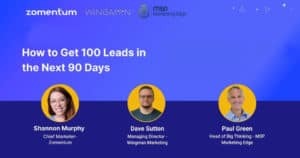 TL;DR: This Zomentum webinar helps Managed Service Providers (MSPs) understand how to reach new clients through varied content, follow-ups, and building relationships. The hosts also share how to deal with the frustration of knockbacks, and how LinkedIn can prove to be more useful a tool than first meets the eye.
TL;DR: This Zomentum webinar helps Managed Service Providers (MSPs) understand how to reach new clients through varied content, follow-ups, and building relationships. The hosts also share how to deal with the frustration of knockbacks, and how LinkedIn can prove to be more useful a tool than first meets the eye.
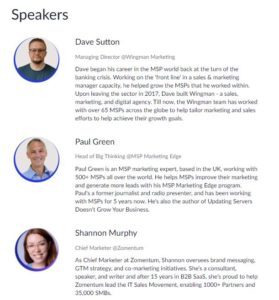 Hosted by Zomentum
Hosted by Zomentum
Watch the on-demand replay of How to get 100 Leads in the next 90 Days.
Speakers:
Shannon Murphy – Chief Marketer at ZomentumDave Sutton – Managing Director of Wingman MarketingPaul Green – Head of Big Thinking at MSP Marketing EdgeHow do I Generate New Leads?This webinar focused on one of the main challenges MSPs face in marketing themselves. How do I generate new leads? We find ourselves asking, what is a good lead?
As a result, Paul Green suggests a good lead is someone you want to do business with.
Dave Sutton gave the opinion that good prospects are those who are facing a potential parting of ways with their current provider, and that the window of opportunity we have to market ourselves to clients in order to secure their business can begin months before their current contracts end.
The team discussed strategies for marketing in more detail for those MSPs who want to generate more new business leads, rather than rely on referrals.

Paul suggested referral-heavy MSPs sometimes appear to operate like the popular builder who never calls you back, and does the bare minimum to keep you happy.
Instead, good marketing relies on three steps to succeed:
Build multiple audiencesCultivate relationships – with your new contactsCommercialise the relationship – and start reaping the benefitsMarketing to multiple audiences allows potential leads to interact with you on their terms.
Give them a range of different mediums to vary the content that you put out. Allow them the option to sign up to a weekly or monthly newsletter.
Dave was keen to emphasize the ‘Daily, Weekly, Monthly’ model so that you engaging your audience at regular intervals.
In any content that you put out, you should ensure your likeability. According to Paul, people are more likely to establish a relationship with you if you’re likeable.
Cultivating RelationshipsCultivate relationships once you have some engagement, get to know the people you reach through your marketing to learn about their current arrangements, their aspirations, and what irks them about their current IT provision.
Therefore, this is an opportunity to learn other things about them and the industries they support, too. You could find future leads that their current marketing doesn’t reach.
As a result, ensure you commercialise the relationship. From your engagement, you should already know how to sell them an MSP solution that suits their circumstances. Even if they’re not ready to commit to a business arrangement, they will be good leads to follow up on later.
Paul talked a bit more in depth about a platform where, for him, marketing strategies have proven particularly useful: LinkedIn. He described it as an “amazing resource” to find potential clients.

Paul suggested that “The Three Cs” win on LinkedIn.
ConnectHe cautioned that you need to use it often to get the most out of it, but that it’s a great place to research potential leads, and other leads that are closely connected. Polls are a really popular way to engage on LinkedIn at the moment.
ContentYour content on LinkedIn, as with other social media, is most valuable in the first three hours of it being posted online. Content should be varied, relevant and easy to access to reach its peak audience. A suggestion was to make your content feel like you’re starting a conversation in order for it to better appeal.
ContactYou should follow up favourable comments and shares, approaching them with personalised messages so you don’t appear like a bot. If they’re not ready to speak to you, ask if you can schedule a time and date more convenient to them. Get them to put it in their diaries, so they’ve made time for you.
“Content is a gift” – Shannon Murphy
Generating Emergency Leads for Your MSPWhen it comes to advice on ‘How to Get 100 Leads in Ninety Days’, the panel offered further advice to generate emergency leads.
Don’t be afraid to pick up the phone if your leads dry up, and set your sights a little lower if you need to. Small leads have the potential to grow.
Build a profile of these leads so that you have a database of future opportunities. This way, you have information to hand should you want to contact them further down the line.
“Sales is ugly” says Dave Sutton. You have to cultivate positive results, and be prepared for a lot of leads that come to nothing. It’s all part of the process.
If you’re expecting potential leads to call your business to find out more, you should make sure your staff are willing and able to have a conversation that says you’re thankful for them taking the time to call. You don’t want to miss out because you’re on another call or away from the office.
You can make a ‘mystery shopper’ call to your own office number, to see if your staff are able to provide excellent customer service and show interest to potential clients.

The amount of leads that will come to nothing can be overwhelming, especially if you’re struggling to land new clients in general.
Therefore, the advice is to keep at it, but there are ways manage the negativity you might feel after constant knockbacks.
When asking ‘How to Get 100 Leads in Ninety Days’, gamification is one way Paul deals with knock-backs. Gamification is when you reward yourself for completing challenging or boring tasks, and encourages you to get over that finishing line and get to where you need to be.
ConclusionThe panel of experts gave us some advice to finish the ‘How to Get 100 Leads in Ninety Days’ webinar.
Dave – Structure CRM to get prospect details. Ask when they’re looking to tender again? How many users do they have? And what is their automation, cloud-based usage at the moment? Get them to open up about what niggles they have with their IT solutionsShannon – Marketing should be consistent and persistent. Build your contacts from lists and local registry sourcesPaul – Recommends reading ‘Unstoppable Referrals’ by Steve Gordon on how to mitigate the ‘social risk’ of a bad referral
 Question and Answer
Question and AnswerThe experts opened up the floor to questions from the live audience.
Question – Any tips for getting past the gatekeeper?In order to not appear like a cold caller, you should structure your follow-ups to reference a previous engagement. For example, “I wanted to discuss a topic we touched base on the other day…”
Question – How can we make our marketing better on social media?Customise your content to reflect the audience you’re marketing to. Make the engagement feel less like a sales pitch.
Question – Is the hunter style door-to-door salesperson a good idea, or a bit old school?It can work, but they need to know their stuff, and know who they’re selling to, and not come across too pushy, or it can backfire.
Question – Is making associations with other groups/industries beneficial for leads?It can be, but you have to have something they want in return for the relationship to work, usually. One MSP specialised in solutions for a corner of the market that wasn’t well represented. They found they had many referrals among that niche thanks to the associations they made as a result.
You Might Also Be Interested InPodcast – Why MSPs Need to Embrace Marketing. An interview with Paul Green.Podcast – How To Accelerate Your MSP Sales for Business Growth. Ben Spector of Zomentum explains MSP Sales.Article – What are the Common Mistakes to Avoid When Marketing your MSP?The post Webinar: How to Get 100 Leads in the next 90 Days appeared first on Richard Tubb.







